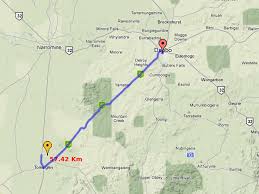Exploring the Convenience of Google Maps Driving Directions
In today’s fast-paced world, getting from point A to point B efficiently is essential. With the advent of technology, navigation has become easier than ever before. One such tool that has revolutionized the way we navigate our world is Google Maps driving directions.
Google Maps offers a user-friendly interface that allows users to input their starting point and destination to receive detailed driving directions. Whether you’re planning a road trip, navigating through an unfamiliar city, or simply trying to find the quickest route to your destination, Google Maps has got you covered.
One of the key features of Google Maps driving directions is real-time traffic updates. By accessing live traffic data, Google Maps can suggest alternate routes to help you avoid congestion and reach your destination faster. This feature is particularly useful during rush hours or when traveling to busy areas.
Moreover, Google Maps provides step-by-step directions accompanied by visual cues such as street view images and satellite imagery. This makes it easier for users to follow the route accurately and make informed decisions while driving.
Another benefit of using Google Maps driving directions is its integration with other Google services. Users can seamlessly switch between maps, satellite view, and street view to get a comprehensive understanding of their route. Additionally, users can save their favorite locations, create custom maps, and share directions with others.
Whether you’re a frequent traveler or someone who relies on navigation occasionally, Google Maps driving directions offer unparalleled convenience and reliability. With its intuitive interface, real-time updates, and comprehensive features, Google Maps has truly transformed the way we navigate our world.
8 Benefits of Google Maps Driving Directions: Navigate Smarter and Easier
- Accurate turn-by-turn navigation
- Real-time traffic updates for efficient route planning
- Integration with other Google services like Street View and satellite imagery
- Ability to save favorite locations for quick access
- Customizable routes based on user preferences
- Voice-guided directions for hands-free navigation
- Offline maps available for use in areas with limited connectivity
- Shareable directions with friends and family
7 Drawbacks of Using Google Maps for Driving Directions
- Dependence on internet connection for real-time updates
- Potential for inaccuracies in mapping data
- Limited offline functionality without pre-downloaded maps
- Privacy concerns related to location tracking
- Battery drain on mobile devices during prolonged use
- Occasional glitches or bugs in the app’s performance
- Difficulty in navigating complex intersections or multiple lanes
Accurate turn-by-turn navigation
Google Maps driving directions provide users with accurate turn-by-turn navigation, ensuring a seamless and stress-free journey from start to finish. By offering precise instructions at each juncture, Google Maps helps drivers navigate complex road networks with ease, reducing the likelihood of wrong turns or missed exits. This feature not only saves time but also enhances road safety by keeping drivers informed and confident throughout their travels. With Google Maps’ reliable turn-by-turn guidance, users can confidently explore new destinations or navigate familiar routes with precision and efficiency.
Real-time traffic updates for efficient route planning
Google Maps driving directions provide real-time traffic updates, a valuable feature that enhances route planning efficiency. By accessing live traffic data, users can receive up-to-the-minute information on road conditions and congestion levels, allowing them to choose the most efficient route to their destination. This proactive approach to navigation helps drivers save time and avoid potential delays, ensuring a smoother and more stress-free travel experience.
Integration with other Google services like Street View and satellite imagery
Google Maps driving directions stand out for their seamless integration with other Google services, such as Street View and satellite imagery. This feature provides users with a comprehensive understanding of their route by offering visual cues and detailed views of the surroundings. By allowing users to switch between different views, Google Maps enhances the navigation experience and helps users make informed decisions while on the road. The integration with Street View and satellite imagery not only adds depth to the directions but also ensures that users have access to accurate and up-to-date information about their journey.
Ability to save favorite locations for quick access
One of the standout advantages of Google Maps driving directions is the ability to save favorite locations for quick access. This feature allows users to effortlessly store frequently visited places, such as home, work, or favorite restaurants, making it convenient to access directions with just a few taps. By saving favorite locations, users can streamline their navigation experience and save time when planning routes, enhancing overall efficiency and convenience in their daily travels.
Customizable routes based on user preferences
Google Maps driving directions offer the valuable advantage of customizable routes based on user preferences. This feature allows users to tailor their routes according to specific criteria such as avoiding toll roads, highways, or even selecting scenic routes. By providing personalized options, Google Maps empowers users to plan their journeys in a way that best suits their needs and preferences, enhancing the overall navigation experience.
Voice-guided directions for hands-free navigation
Google Maps driving directions offer the convenient feature of voice-guided directions, allowing users to navigate hands-free. This innovative functionality enables drivers to focus on the road ahead while receiving turn-by-turn instructions verbally. By providing real-time guidance through audio cues, Google Maps ensures a safer and more user-friendly navigation experience, particularly useful for drivers who need to keep their hands on the wheel and eyes on the road. The voice-guided directions feature enhances convenience and accessibility, making it easier for users to reach their destinations efficiently while prioritizing safety.
Offline maps available for use in areas with limited connectivity
Google Maps driving directions offer the invaluable benefit of offline maps, allowing users to access navigation even in areas with limited connectivity. This feature is particularly useful for travelers exploring remote locations or individuals navigating through areas with poor network coverage. By downloading maps in advance, users can confidently rely on Google Maps to provide accurate directions and guidance, ensuring a seamless navigation experience regardless of internet availability.
Shareable directions with friends and family
Google Maps driving directions offer the convenient feature of shareable directions with friends and family. With just a few clicks, users can easily share their planned routes, favorite locations, or specific addresses with others. This functionality is especially useful for coordinating meetups, road trips, or simply helping someone navigate to a new place. By sharing directions through Google Maps, users can ensure that their loved ones reach their destinations safely and efficiently, fostering better communication and connectivity among friends and family members.
Dependence on internet connection for real-time updates
One notable drawback of relying on Google Maps driving directions is the dependency on an internet connection for real-time updates. While the live traffic data and alternate route suggestions are valuable features, they become inaccessible in areas with poor or no internet connectivity. This limitation can pose challenges when navigating through remote locations or areas with weak signal strength, potentially leaving users without crucial information to adjust their routes efficiently. As a result, the reliance on internet access for real-time updates may hinder the reliability and functionality of Google Maps driving directions in certain circumstances.
Potential for inaccuracies in mapping data
One significant drawback of Google Maps driving directions is the potential for inaccuracies in mapping data. Despite its advanced technology and vast database, Google Maps can sometimes provide incorrect or outdated information regarding routes, locations, or points of interest. This can lead to confusion, frustration, and even safety concerns for users who rely heavily on the accuracy of the mapping data. It is important for users to exercise caution and verify information from alternative sources when using Google Maps to ensure a smooth and reliable navigation experience.
Limited offline functionality without pre-downloaded maps
One notable drawback of Google Maps driving directions is its limited offline functionality when access to the internet is not available. Without pre-downloaded maps, users may find themselves unable to access detailed routes or real-time updates when navigating in areas with poor connectivity. This limitation can be particularly inconvenient for travelers exploring remote locations or for those who rely on navigation in areas with unreliable internet access. As a result, users may need to plan ahead by downloading maps in advance to ensure seamless navigation even when offline.
Privacy concerns related to location tracking
Privacy concerns related to location tracking are a significant con of using Google Maps driving directions. While the app provides valuable navigation assistance, it also collects and stores users’ location data, raising potential privacy issues. Some users may feel uncomfortable with the idea of their movements being tracked and recorded by a tech giant like Google. This data can be used for targeted advertising, personalized recommendations, or even shared with third parties, raising questions about data security and user privacy. As such, individuals concerned about their privacy may hesitate to fully embrace the convenience of Google Maps driving directions due to these ongoing privacy considerations.
Battery drain on mobile devices during prolonged use
One drawback of relying on Google Maps driving directions is the significant battery drain it can cause on mobile devices, especially during prolonged use. Constantly using the GPS feature and displaying real-time navigation instructions can quickly deplete the battery life of smartphones and tablets. This dependency on Google Maps for extended periods may require users to carry additional charging accessories or limit their usage to conserve battery power, which can be inconvenient, especially when navigating in remote areas or during long road trips.
Occasional glitches or bugs in the app’s performance
Occasional glitches or bugs in the app’s performance can be a frustrating con of Google Maps driving directions. Users may encounter issues such as inaccurate route calculations, delayed updates on traffic conditions, or unexpected app crashes, which can disrupt their navigation experience. These glitches can lead to confusion and inconvenience, especially when relying on the app for timely and accurate directions. While Google continuously works to improve the app’s performance through updates and fixes, occasional technical issues remain a drawback for users seeking seamless navigation assistance.
Difficulty in navigating complex intersections or multiple lanes
One notable drawback of Google Maps driving directions is the difficulty it presents in navigating complex intersections or multiple lanes. In densely populated urban areas or intricate highway systems, the app may not always provide clear instructions for lane changes or intricate turns, leading to confusion and potential missed exits. This limitation can be frustrating for drivers who rely heavily on precise guidance, especially in high-traffic situations where quick decisions are crucial. As a result, users may find themselves in challenging driving scenarios that require additional focus and interpretation beyond what Google Maps provides.






